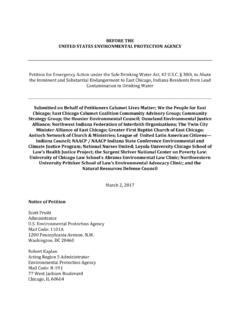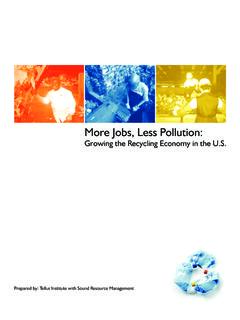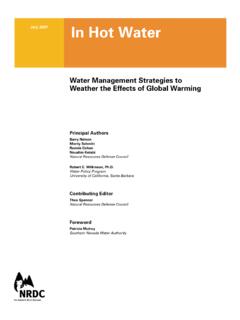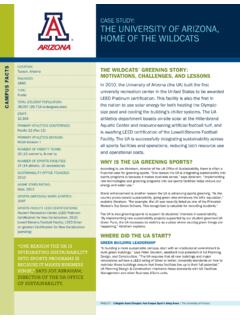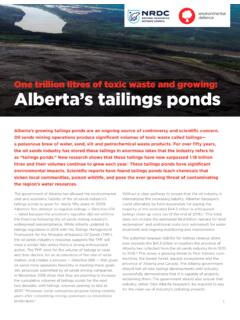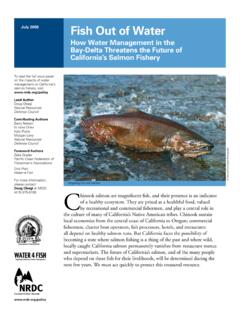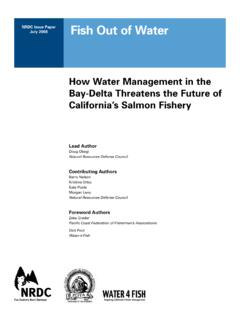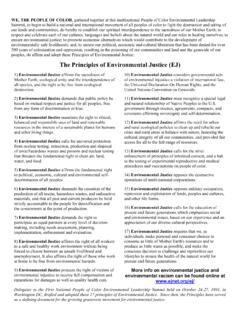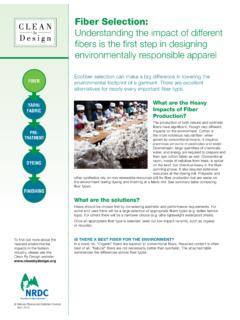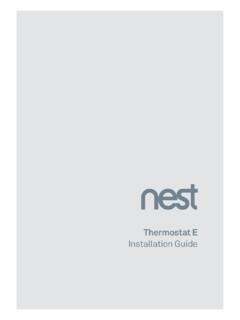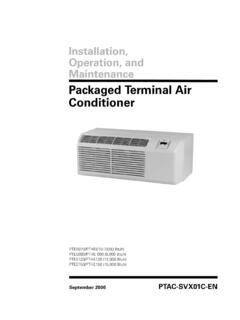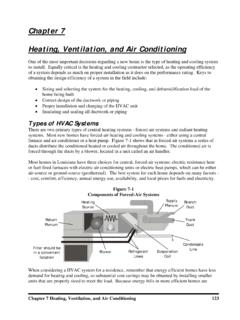Transcription of HEAT PUMP RETROFIT STRATEGIES FOR MULTIFAMILY …
1 heat PUMP RETROFIT STRATEGIES FOR MULTIFAMILY BUILDINGS April 2019 Prepared for: Natural Resources Defense Council Pierre Delforge Lindsay Robbins Prepared by: Steven Winter Associates, Inc. In Partnership with: Steven Winter Associates, Inc. 2 EXECUTIVE SUMMARY heat pump conversions of existing MULTIFAMILY buildings are an important part of many climate action plans for metropolitan areas around the United ,2,3,4 The main advantages of heat pumps in these action plans is to increase heating efficiency significantly beyond what even the best combustion systems can provide. In addition, moving from combustion-based heating systems to electricity-driven systems offers the benefit of using renewable energy instead of fossil MULTIFAMILY buildings, defined here as having five apartments or more, that use fuel-based space heating or domestic hot water systems, have widely varying vintages and construction types across the Retrofitting the mechanical systems of a MULTIFAMILY building can be complex, depending on a mix of technical and non-technical While multiple effective solutions are commercially available, MULTIFAMILY building heat pump integration considerations are not widely understood across the This gap is an obstacle to adoption of heat pumps in MULTIFAMILY buildings.
2 This report aims to help market and policy actors in the MULTIFAMILY building sector better understand the technology options currently available to electrify combustion-based heating and hot water systems, in the pursuit of better environmental, economic and health outcomes. This study segments existing MULTIFAMILY buildings in the into typologies based on size and existing heating system. These characteristics affect what types of heat pumps are applicable in a RETROFIT situation along with climate-specific considerations. This report is not meant to describe all possible heat pump retrofits to heating systems, instead it represents many of the viable options based on today s technology. As supply of and demand for heat pumps change, along with developments of local and national regulations, new opportunities for retrofits may arise. This report is meant to illustrate potential RETROFIT project types, not to be conclusive in an evolving field of technology.
3 Section 1: Typologies of Existing MULTIFAMILY Buildings characterizes the national MULTIFAMILY building stock along key attributes that govern the viability of possible heat pump RETROFIT projects. Each segment is roughly quantified nationally and by geographic region. The characterization generally shows that combustion-based MULTIFAMILY buildings are concentrated in dense urban areas in colder climates, which frequently use whole building central heating plants. Milder climates tend to have a higher proportion of decentralized heating systems and a higher proportion of electric heating. The key attributes of combustion-based heating system and building height are used to segment the MULTIFAMILY building stock into six typologies: x Steam heated high-rise x Steam heated low-rise x Hot water heated high-rise x Hot water heated low-rise x Forced air furnace heated x Wall furnace or other room-by-room heated heat pump retrofits are segmented into major categories by location of outdoor equipment and distribution systems.
4 The categories of retrofits are applied to the building types. Domestic hot water (DHW) system retrofits are segmented in terms of existing conditions: x Central DHW plant x Distributed, tenant-space DHW plants Section 2: RETROFIT Primer for MULTIFAMILY Building Typologies describes a basic project scope, capabilities and availability of current technology for nine types of retrofits. Seven project types are for space heating and Steven Winter Associates, Inc. 3 cooling, and two are for domestic hot water projects. Each combination of existing system type and heat pump technology is detailed along the lines of particular advantages, climate and geography considerations, complexity of installation, and existing barriers that need resolution to improve performance or economics. For direct comparison of key components of the projects, see Table 2 and Table 3. Key takeaways are that the lack of a simple and repeatable heat pump RETROFIT is a market gap that could potentially be filled by a high-performance packaged terminal unit, and that central heat pump systems may offer superlative performance, but more case studies of successful projects are needed to strengthen the value proposition.
5 Appendix A: Cost Estimates - Includes rough cost estimates for each technology type and for different building typologies, where applicable. Equipment costs may not vary much from one region of the country to another, but labor costs do. Appendix B: Relative Labor Costs for Installers - Compares regional labor rates. Labor costs are roughly estimated to make up 50% of the RETROFIT project costs, so if labor rates are 50% less than the baseline region (New England/New York), the RETROFIT may cost 25% less than estimated in this paper. Costs are illustrative for general comparison between technology types, but project specific factors can multiply RETROFIT costs in unpredictable ways. In addition, some technologies are incentivized by utilities and governments. For example, ground source heat pumps receive federal tax credits9 not reflected in the gross cost. When pursuing changes to such fundamental systems in existing buildings, there are few absolute rules that predict the complexity, cost, and success of a heat pump RETROFIT project for any specific building.
6 The considerations described in this paper are to help understand the main options for general categories of buildings and provide context during conversations involving retrofits of existing combustion-based systems in MULTIFAMILY buildings with electric heat pumps . As more retrofits are completed across the country, case studies for specific circumstances will provide indications of convergence on considerations around cost, optimal technology, and RETROFIT scopes. Further study is needed to answer open questions around: x Real-world refrigerant leakage rates of different technologies and installation types x How to mitigate concerns around installation complexity and refrigerants x Repeatability of results for RETROFIT types across a certain building type convergence of aspects of heat pump retrofits to enable better cost and feasibility estimates, which can help shape policy and incentive discussions going forward.
7 Steven Winter Associates, Inc. 4 REPORT CONTENTS Executive Summary .. 2 5 heat pumps Defined .. 6 heat Delivery Methods .. 6 heat pumps Use Refrigerants .. 7 Section 1: Typologies of Existing MULTIFAMILY Buildings .. 9 Space Heating and Cooling Typologies .. 9 Methodology - Typology Determination .. 10 Domestic Hot Water .. 15 Section 2: RETROFIT Primer for MULTIFAMILY Building Typologies .. 17 RETROFIT Project 1: Steam or Hot Water Central heat pumps with Hydronic Distribution .. 17 RETROFIT Project 2: Steam or Hot Water Ground Loop Hydronic with Room-by-Room heat pumps .. 21 RETROFIT Project 3: Steam or Hot Water packaged Terminal heat pumps (PTHP) .. 24 RETROFIT Project 4: Steam or Hot Water High Rise Central heat pumps with Refrigerant Distribution .. 27 RETROFIT Project 5: Steam High-Rise and Steam or Hot Water Low-Rise Mini-Split heat pumps Serving Single Apartments .. 30 RETROFIT Project 6: Hot Air Furnace Split heat pumps Serving Single Apartments with Ducting.
8 33 RETROFIT Project 7: packaged gas room heaters packaged Terminal heat pumps (PTHP) .. 35 RETROFIT Project 8: DHW: Central DHW Plant Central AWHP Plant .. 38 RETROFIT Project 9: DHW: Per-Apartment DHW Per-Apartment heat Pump Water Heaters .. 41 Comparison Tables for RETROFIT Project Types .. 44 Appendix A: Cost Estimates .. 46 Appendix B: Relative Labor Costs for Installers .. 48 Appendix C: Geographic Division and Climate Zone Maps .. 49 Steven Winter Associates, Inc. 5 DEFINITIONS AWHP: Air-to-water heat pump, also known as a reverse-cycle chiller, which exchanges energy with outdoor air to condition water for heating and cooling. In some buildings, a source of warm air other than outdoor air may be available for use as a heating energy source, but in most MULTIFAMILY scenarios, the air source will be ambient outdoor air BA Climate Zone: Building America Climate Zone definitions used in RECS see Appendix B for zone divisions ccASHP: cold-climate air source heat pump, typically a split heat pump for residential or single apartment use, that can hold its rated capacity down to an ambient air temperature of five degrees Fahrenheit DHW: Domestic hot water EPA: Environmental Protection Agency GHG: Those gases, such as water vapor, carbon dioxide, nitrous oxide, methane, hydrofluorocarbons (HFCs), perfluorocarbons (PFCs) and sulfur hexafluoride, that are transparent to solar (short-wave) radiation but opaque to long-wave (infrared) radiation, thus preventing long-wave radiant energy from leaving Earth's atmosphere.
9 The net effect is a trapping of absorbed radiation and a tendency to warm the planet's surface10 GSHP: Ground-source heat pump - a water source heat pump which exchanges heat with the ground using water piping GWP: Global Warming Potential, an index used to compare the relative radiative forcing of different gases without directly calculating the changes in atmospheric concentrations. GWPs are calculated as the ratio of the radiative forcing that would result from the emission of one kilogram of a greenhouse gas to that from the emission of one kilogram of carbon dioxide over a fixed period of time, such as 100 years11 HPWH: heat pump water heater, a term generally referring to integrated tank water heaters used in single family homes; technically these are a form of air-to-water heat pumps MBH: Thousand BTU per hour, BTU being a British Thermal Unit, or 1/3,412 kWh Mini-split: a small capacity split heat pump that can serve up to four zones (typically) with a single small outdoor unit located nearby on an outside wall or roof.
10 These systems are commonly used to add cooling to a home as a middle ground between window air conditioner units and a whole-house central cooling system PTAC: packaged terminal air conditioner, sometimes paired with a heating coil from a central steam or hot water plant, or direct gas-fired or electric resistance heat PTHP: packaged terminal heat pump RECS: Residential Energy Consumption Survey, a study completed by the Energy Information Agency to classify housing types across the United States TBTU: Trillion BTU VRF: Variable refrigerant flow, a name used in industry to define central heat pump plants with refrigerant distribution systems serving multiple spaces WSHP: Water source heat pump, meaning a water to air heat pump in this context Steven Winter Associates, Inc. 6 heat pumps DEFINED For the purposes of this report, the following definition of heat pumps is appropriate: An electric heat pump is an energy efficient heating and cooling system that can heat buildings by moving heat from outdoors to indoors (during winter) and cool buildings by moving heat from indoors to outdoors (during summer).
